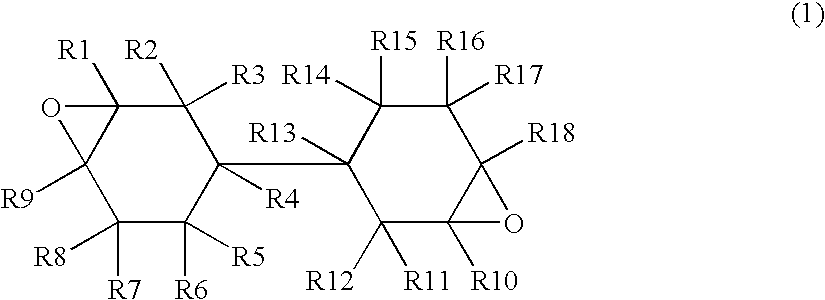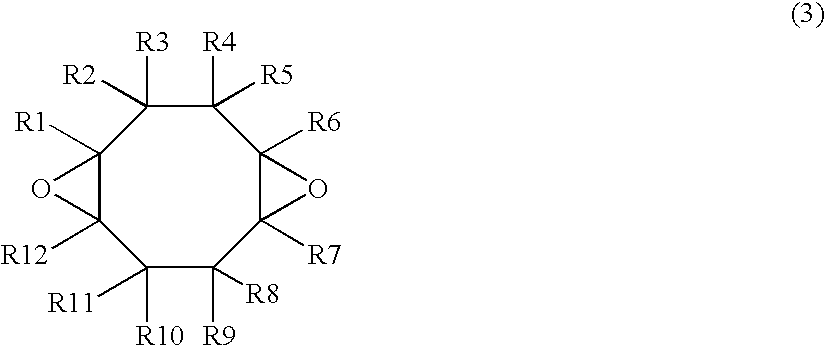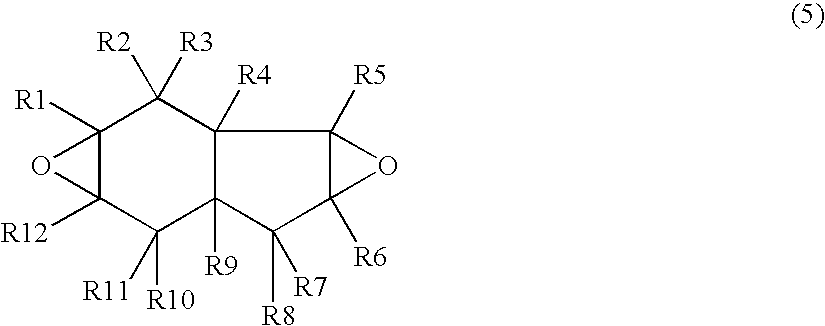Thermosetting epoxy resin composition and transparent material
a technology of epoxy resin and composition, which is applied in the direction of synthetic resin layered products, layered products, chemistry apparatus and processes, etc., can solve the problems of insufficient heat resistance and optical transparency of thermoplastic resins as replacement, and the now-commercially available aromatic epoxy resins are also insufficient in optical transparency of cured articles therefrom, so as to achieve heat resistance and dimensional stability of epoxy resins, the effect of maintaining optical transparency
- Summary
- Abstract
- Description
- Claims
- Application Information
AI Technical Summary
Benefits of technology
Problems solved by technology
Method used
Image
Examples
synthesis example 1
(A) Synthesis of Ester-Free Alicyclic Epoxy Compound A-1
[0049] In a reactor were placed 406 g of bicyclohexyl-3,3′-diene, an example of the compounds of Formula (2), and 1217 g of ethyl acetate. While passing nitrogen gas through the gas phase and keeping the inner temperature of the reactor to 37.5° C., 457 g of a 30 percent by weight solution of peroxyacetic acid in ethyl acetate (moisture content: 0.41 percent by weight) was added dropwise over about 3 hours. After the completion of dropwise addition, the mixture was stirred at 40° C. for one hour and the epoxidation completed. Next, the reactor was cooled to 30° C., and the crude reaction mixture was washed with water. Subsequently, low boiling components were removed from the crude reaction mixture at 70° C. and 20 mmHg (2660 Pa) to yield 415 g of an epoxy compound (bicyclohexyl-3,4,3′,4′-diepoxide). The obtained epoxy compound is hereinbelow referred to as A-1. A-1 has an oxirane oxygen content of 14.7 percent by weight and w...
synthesis example 2
(A) Synthesis of Ester-Free Alicyclic Epoxy Compound A-2
[0051] In a reactor were placed 108 g of cyclooctadiene, an example of the compounds of Formula (4), and 108 g of ethyl acetate. While passing nitrogen gas through the gas phase and keeping the inner temperature of the reactor to 30° C., 532 g of a 30 percent by weight solution of peroxyacetic acid in ethyl acetate (moisture content: 0.41 percent by weight) was added dropwise over about 3 hours. After the completion of dropwise addition, the mixture was stirred at 30° C. for 5 hours and the epoxidation completed. Next, the reactor was cooled to 20° C., 86.9 g of sodium carbonate was added to the stirred crude reaction mixture, 219 g of a 10% aqueous NaOH solution was further added, the reaction mixture was left stand, and the lower aqueous phase was extracted. After repeating this procedure three times, residual neutralized salts were washed twice by adding 250 g of deionized water to the residual organic phase. Subsequently, ...
synthesis example 3
(A) Synthesis of Ester-Free Alicyclic Epoxy Compound A-3
[0052] In a reactor were placed 240 g of 3a,4,7,7a-tetrahydroindene, an example of the compounds of Formula (6), and 480 g of ethyl acetate. While passing nitrogen gas through the gas phase and keeping the inner temperature of the reactor to 30° C., 1220 g of a 30 percent by weight solution of peroxyacetic acid in ethyl acetate (moisture content: 0.41 percent by weight) was added dropwise over about 3 hours. After the completion of dropwise addition, the mixture was stirred at 30° C. for 6 hours and the epoxidation completed. Next, the reactor was cooled to 20° C., 398 g of sodium carbonate was added to the stirred crude reaction mixture, 1500 g of a 10% aqueous NaOH solution was further added, the reaction mixture was left stand, and the lower aqueous phase was extracted. Residual neutralized salts were washed out by adding 1000 g of deionized water to the residual organic phase. Subsequently, low boiling components were remo...
PUM
| Property | Measurement | Unit |
|---|---|---|
| temperature | aaaaa | aaaaa |
| temperature | aaaaa | aaaaa |
| temperature | aaaaa | aaaaa |
Abstract
Description
Claims
Application Information
 Login to View More
Login to View More - R&D
- Intellectual Property
- Life Sciences
- Materials
- Tech Scout
- Unparalleled Data Quality
- Higher Quality Content
- 60% Fewer Hallucinations
Browse by: Latest US Patents, China's latest patents, Technical Efficacy Thesaurus, Application Domain, Technology Topic, Popular Technical Reports.
© 2025 PatSnap. All rights reserved.Legal|Privacy policy|Modern Slavery Act Transparency Statement|Sitemap|About US| Contact US: help@patsnap.com



